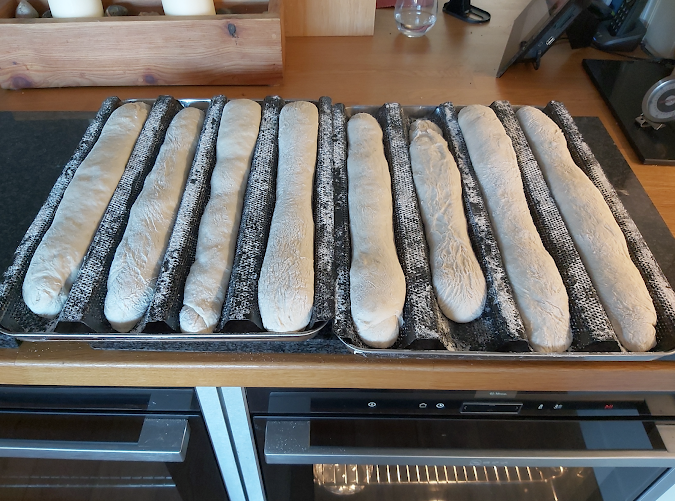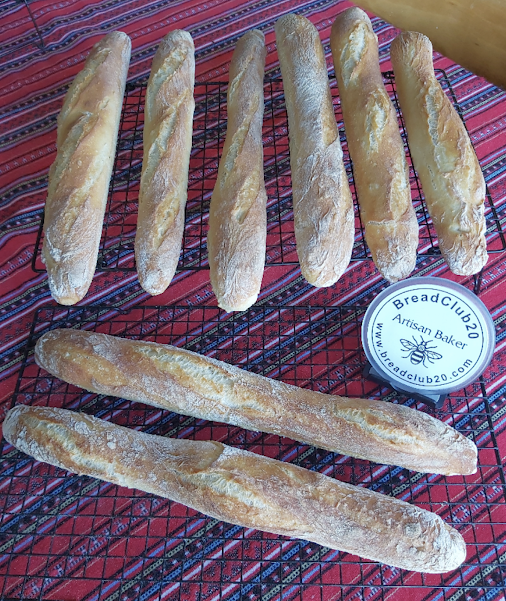Baguette de Tradition Française
BreadClub20....the award-winning site for Happy Bakers.
2021 : World Bread Awards : Winner - Wales
Welcome to another step-by-step recipe from BreadClub20. Why not drop by our main Facebook page by clicking here.... If you like what you see and enjoy the recipe, we hope you go on to join us by 'Liking' and 'Subscribing'.
I'm off to a 55th Wedding Anniversary and, as usual, I've asked the hosts what they would like me to bring.
Can you make an authentic French baguette...the sort we used to buy when we went to Paris?
French baguettes take time and you need to plan ahead. True, there are lots of quicker recipes for 'lookalike' French baguettes - made with a poolish or with a sourdough starter. However, we must remember one very important thing...the ingredients for a true baguette tradition are enshrined in law.
In 1993, the French government passed the law known as the Décret Pain. The legislature made clear the provenance for all French breads.
The traditional baguette has to be made on the premises from which it is sold (or eaten, or given away). It can only be made with four ingredients: wheat flour, water, salt and yeast. They can't be frozen or have preservatives added to them. And they usually go stale within 24 hours.
As for size, the baguette tradition should have a diameter of 6 - 8 cms and be no shorter than 26 scms and no longer than a metre.
The whole letter of the law is spelt out here: https://www.cooksinfo.com/french-bread-law-1993. In fact, Google even celebrated the 22nd Anniversary of the Décret Pain, back in 2015.
In 2021, the baguette tradition was listed for UNESCO World Heritage status.
A previous ruling of 1920 dictated that it should be 80 gms in weight and 40 cms in length. This only changed after the war when French bread was at an all-time low and standards were set to encourage France to return to its rightful place as one of the finest bread making countries in the world.
So, the Baguette Tradition is made with T55 flour, salt, yeast and water. And, that is it! The key is to take your time and the longer you take, the better the end product.
Well, I'm not selling by baguettes, I'm simply wrapping them up, packing them in a backpack and hiking over the fields to my friends' house to celebrate their many years of marriage. I hope they pass muster.
INGREDIENTS
1000 gms of T55 bread flour
720 mls tepid filtered water
1 teaspoon instant active yeast
10 gms sea salt.
METHOD
Room temperature = 20⁰C.
A 'warm environment' = 24⁰C - 26⁰C
1. Mix the flour and the yeast together. Add the salt to the water and add to the flour and the yeast. Mix thoroughly. Cover and leave to autolyse at room temperature for 30 minutes.
2. At 30 minute intervals, carry out three sets of stretch and fold (total time 1.5 hours). Flip the dough over after each set. Cover in between sets.
3. Cover the bowl and refrigerate overnight.
5. Divide the dough into eight equal parts
6. Shape the dough portions into rectangles. Cover and let rest at room temperature for 60 minutes.
7. Stretch each portion of dough slightly and fold into a cylinder. Roll the dough out to the required length.
8. Place the baguettes on a lightly-floured couche, seam side up. Cover and proof at room temperature for sixty minutes or until the dough has sufficiently proofed.
9. Pre-heat the oven to 240⁰C. If you're using a baking steel, tray or stone, remember to pre-heat these as well. Add a small bowl of water to provide steam.
10. Transfer the baguettes to pieces of parchment paper , seam side down and dust off excess flour. Score each baguette.
 |
| Before scoring and misting |
11. Bake for 15 minutes at 240⁰C.
12. Remove the water pan, drop the temperature to 230⁰C and continue to bake for a further 15 minutes or until golden brown.
Cool on a rack.
Crusty, thin, tasty...and they're not going to last very long...
Happy baking...







Comments
Post a Comment